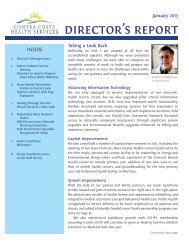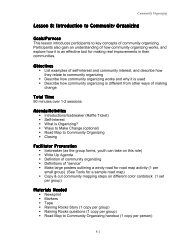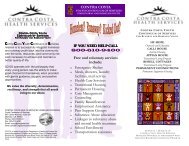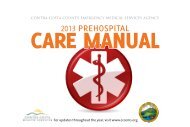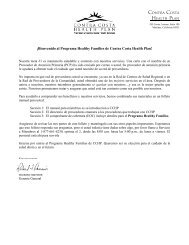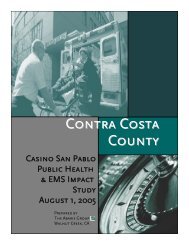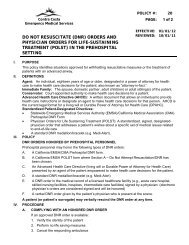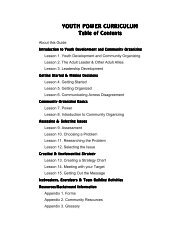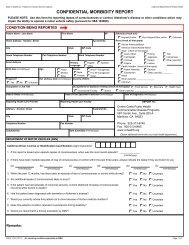EMS Policy Manual - Contra Costa Health Services
EMS Policy Manual - Contra Costa Health Services
EMS Policy Manual - Contra Costa Health Services
You also want an ePaper? Increase the reach of your titles
YUMPU automatically turns print PDFs into web optimized ePapers that Google loves.
<strong>Contra</strong> <strong>Costa</strong><br />
Emergency Medical <strong>Services</strong><br />
HOSPITAL GUIDELINES FOR ACUTE CARE<br />
INTERFACILITY TRANSFER VIA AMBULANCE<br />
POLICY #: 15<br />
PAGE: 1 of 4<br />
EFFECTIVE: 07/05/11<br />
REVIEWED: 07/05/11<br />
I. PURPOSE<br />
This policy describes options for interfacility transfer between acute care hospitals and the procedures<br />
required to arrange transport. Transport options vary in terms of accompanying personnel, scope of<br />
practice provided and timeliness of availability.<br />
Transports from other facilities (e.g. nursing homes, clinics, or other facilities that are not licensed to<br />
provide acute inpatient care) are not acute care interfacility transfers.<br />
II. TRANSPORT OPTIONS FOR ACUTE CARE INTERFACILITY TRANSFER<br />
It is the responsibility of the transferring hospital/facility to select the transport option appropriate for<br />
the patient’s condition.<br />
A. Emergency Paramedic Ambulance Transport (Interfacility Emergency Response)<br />
To be used for patient transfer between two acute care hospitals that requires critical timely<br />
interventions or evaluation at another hospital when that care is not available at the sending<br />
hospital.<br />
1. Interfacility Emergency Response Capabilities<br />
a. The emergency ambulance provider for the area in which the hospital is located will<br />
respond for these transports as an emergency response.<br />
b. Provides paramedic-level service with a single paramedic providing care in the<br />
ambulance. Refer to scope of practice matrix on page three.<br />
i. Protocols for any patient treatment administered by paramedics during the transport<br />
are determined by <strong>Contra</strong> <strong>Costa</strong> Emergency Medical <strong>Services</strong> (<strong>EMS</strong>) policy and<br />
procedures.<br />
ii. When patient needs exceed paramedic scope of practice or when care may require<br />
more than one person, sending facility must provide additional personnel or<br />
equipment.<br />
c. Arrival at the sending facility is generally within ten minutes. Patient should be ready for<br />
transport when ambulance arrives.<br />
2. Examples would include:<br />
a. Critical trauma care<br />
b. Cardiac or Stroke interventional care<br />
c. Obstetric care - patients in active labor (excluding those with imminent or possible<br />
precipitous delivery)<br />
d. Other clinical situations which require specialty emergent care not available at the sending<br />
facility (e.g. vascular surgery)<br />
B. Other Acute Care Transports<br />
The timeliness and availability of other acute care transfers that do not involve a 9-1-1 paramedic<br />
ambulance response (Interfacility Emergency Response) are not within <strong>Contra</strong> <strong>Costa</strong> <strong>EMS</strong><br />
oversight or control.<br />
1. EMT-I Ambulance<br />
Provides EMT-I level service with a single EMT-I providing care in the ambulance. Refer<br />
to scope of practice matrix on page three.<br />
Arrival time based on availability.<br />
Numerous private EMT-I ambulance providers are available to provide this service.



